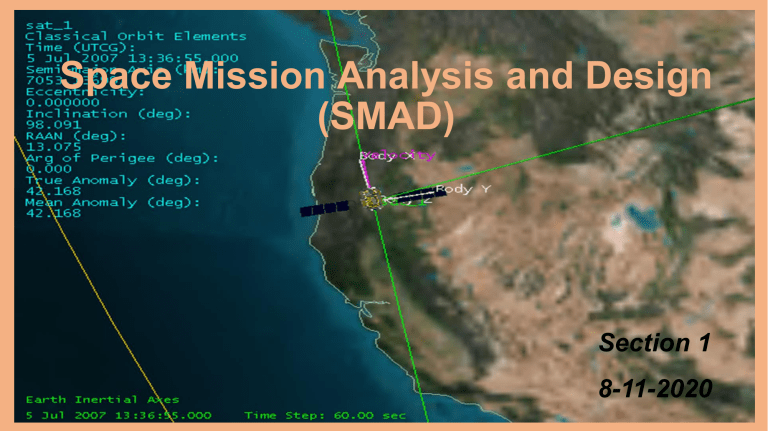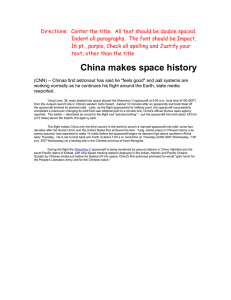
Space Mission Analysis and Design
(SMAD)
Section 1
8-11-2020
Course Data
1
Course Name
Space Mission Analysis1
2
3
Course Code
Credit Hours/Week
SNS 305
3 Hours
4
5
Lecture (LT)
Tutorials (TU)
2 Hours
3 Hours
6
Laboratory (LB)
----------
Course Data
Course Syllabus:
Space mission life cycle – Mission objectives – Mission requirements and constraints –
Mission architectures – Mission drivers – Mission evaluation – Earth geometry –
Apparent motion of satellites, budgets – Keplerian orbits – Orbit perturbations – Orbit
maneuvering – Launch windows – Orbit maintenance – Orbit design process – Earth
coverage – ΔV budget – Orbit selection – Orbit transfer – Parking orbits –
Constellation design – Space environments and survivability – Payload mission
requirements - Payload design and sizing process – Spacecraft design requirements and
constraints – Spacecraft design and sizing process - Spacecraft configuration – Design
budgets, Integration of spacecraft design
Course Data
Main Text Books:
James R. Wertz and Wiley J. Larson, Space Mission Analysis
and Design (SMAD), 3rd Edition, EI Segundo, CA, Microcosm
Press, 1999.
Charles D. Brown, Spacecraft Mission Design1998.
Peter Fortescue, Spacecraft Systems Engineering, 3rd Edition,
Wiley, 2003.
Course Data
Objectives:
Knowledge of Space mission life cycle & Requirements & Constraints .
Knowledge of Keplerian orbits & Orbit perturbations & Orbit maneuvering.
Ability to perform Space Mission Analysis & Design;
Knowledge of Spacecraft design requirements & Constraints & Design &
Sizing process & Configuration & Budgets & Integration.
Document the design process in sufficient detail that another engineer can
continue on with the work just by going through the document.
Space Mission Analysis and Design
SMAD References:
There are now a number of references available on mission design
process Broad objective and constraints are the key to this process.
Rechtin [1991] : an American system engineer and respected authority
in aero space system and system architecture.
Ruskin – Estes [1995] : provide general discussions of this process and
project management.
Robert Shishko [1995] : provide an overview from the NASA
perspective (Nasa engineering hand book).
Wertz – Larson [1996] : discuss this process from the perspective very
low cost missions and methods.
Space Mission Analysis and Design
SMAD:
this processes / procedures which begins with one or more objective and
constraints to define space system by lowest possible cost.
Broad objective and constraints are the key to this process.
We must get the most performance for the moony spent and must require of
system only what it can reasonably achieve.
We must be understanding mission to achieve this objectives like
communication, navigation, Observation and remote sensing, etc.
Space System
Space Mission Process
Space Mission Process
Space Mission Process
Space Mission Process
To understanding mission analysis and have a useful starting point for
any space mission analysis – we can study an example of mission
statement like { Fire Sat (a hypothetical space mission)}
Mission Statement
Because forest fires have an increasing impact on recreation and commerce
and ever higher public visibility, Europe needs a more effective system to
identify and monitor them. In addition, it would be desirable (but not required)
to monitor forest fires for other nations; collect statistical data on fire
outbreaks, spread, speed, and duration; and provide other forest management
data.
Ultimately, the Forestry Commission's fire-monitoring office and wardens in the
field will use the data. Data flow and formats must meet the needs of both
groups without specialized training and must allow them to respond promptly
to changing conditions.
Space Mission Process
Using the Fire Sat example, we can define a set of mission objectives as:
Define broad objectives and constraints.
Space Mission Process
Estimate quantitative mission needs and requirements.
From Fire Sat example, we can define a set of mission requirements as:
Functional Requirements:
System performance to meet its mission objective.
Operational Requirements:
System operates.
Users interact with the system to achieve the mission’s objectives.
Constraints:
limitations imposed on system designer by cost, schedule, and
implementation techniques.
Thanks for Attention
Best
wishes


